Dog Breeds: Hounds
If you want to buy a book, clicking on the book cover
will take you directly to that book on the Amazon.co.uk web site.
See also:
 Dogs:
Breed profiles and breed books Dogs:
Breed profiles and breed books
 Dogs:
Health and Nutrition Dogs:
Health and Nutrition
 Dogs:
General Dogs:
General
 Dogs:
Origins, canine evolution and wolves Dogs:
Origins, canine evolution and wolves
 Training, puppy and adult dog good manners Training, puppy and adult dog good manners
 Advanced training, including gundog training Advanced training, including gundog training
 Fiction and biography relating
to dogs Fiction and biography relating
to dogs
 Ferrets: General advice Ferrets: General advice
 Ferrets: Books on ferrets Ferrets: Books on ferrets
 Click
here for hounds on stamps Click
here for hounds on stamps
|
Click on the above image to see more
stamps featuring dogs
|
General overview
The hound group was developed to hunt with humans and go after their quarry
to corner or catch it. Hounds developed to catch small prey like hares need
a lot of training and management, so that they do not use their skills on
the local cats, and this applies especially to sighthounds, like greyhounds.
You may find that your own cat is respected, but any intruder, or cat spotted
on walks, is seen as prey, so sighthounds are generally best walked on leads
if you live somewhere where there are a lot of cats. Sighthounds are those
hounds which use vision to locate and follow prey, and they can get up to
very high speeds - hence many are also used as racing dogs. Greyhounds tend
not to need long periods of exercise, though they do enjoy a good sprint,
followed by a long nap on a soft sofa. Salukis need rather more exercise.
Lurchers are often used as working dogs, especially to catch rabbits, and
get their exercise that way. Sighthounds often take part in lure coursing,
which you can get involved in just for fun, and to allow your dog to do what
he has been designed to do, run fast. Generally speaking, it's the distance
covered that is important, rather than the amount of time spent exercising,
so the amount of time for exercise that sighthounds need depends on how much
they run while they are out. Many sighthounds love to chase each other, and
it can be a spectacular sight. Some also have a habit of rushing up to other
dogs to encourage them to play. Most non-sighthounds have no hope of keeping
up with a sighthound running in mad circles, though many will try. When not
running, sighthounds like soft beds, since they are generally bony dogs, and
can feel uncomfortable on hard floors. Sighthounds include some very graceful
and elegant dogs, such as Afghans, Borzoi, and Salukis.
Scenthounds, like bassets, beagles and bloodhounds, track their prey using
their noses, and tend to be noisier than sighthounds. Both scenthounds and
sighthounds tend to go deaf when they have sensed interesting animals to chase.
This means that exercising all hounds safely can be a problem. It is wise
to have a large, well-fenced garden before taking on a hound, and even better
if you have a few acres! It's also a good idea to take them to a safe area
where they can run without being endangered by traffic. Some hounds can be
trusted to come back, even if they do tend to rush off. Others can never be
off outside a fenced area because of the risk of their getting lost. You do
need to think seriously about how you are going to exercise your dog safely
before choosing a hound, so you don't end up with an under-exercised dog that
is climbing up the walls.
Good manners are best taught from puppyhood, because it's easier, but adult
rescue dogs can still learn fast. The best time to teach good manners to a
rescue dog is as soon as the dog arrives. That is when the dog is watching
you to learn what the rules are. It's tempting to spoil the dog a bit, because
you feel sorry for him or her. But it's kinder in the long run to let the
dog know gently and firmly what you consider to be appropriate behaviour.
Rescue centres usually have their own behaviourists and provide ongoing help
for adopters. Gwen Bailey's 'The Rescue Dog' is also full of good advice.
Hounds bred to work independently of humans retain this independence when
it comes to obedience training, and are not the most obedient of dogs. Some
are more difficult to train than others. Afghans, far from being stupid, as
some people think, can be quite inventively disobedient. On the plus side,
hounds are usually gentle with people, in the sense that they are less likely
to bite than most breed types, though they do, of course, need to be taught
bite inhibition as pups, and they have been known to knock or pull people
over when in pursuit of prey. Hounds also tend to have strong prey drive,
and can nip when excited, especially if a human gets between them and their
prey. Hound breeds designed to work in packs tend to get on well with other
dogs. This generally easy-going nature of hounds can lull owners into a false
sense of security, and hounds that normally get on well can suddenly have
serious spats, especially if large numbers of them are kept in a relatively
small space, and they do not get enough exercise.
Getting lost, and being hit by cars are threats to all hounds. Too much exercise
and the wrong sort of food can be damaging, especially for puppies of large
hound breeds. (We have put Irish Wolfhounds in the Giant Breed category, because
of these problems, though they are also sighthounds). Sighthounds also tend
to be more sensitive to veterinary pharmaceutical products, especially anaesthetics,
flea collars, and worming products, than most dogs, because they have so little
body fat. Care should also be taken about contact with garden chemicals, such
as fertilisers. Scenthounds tend to have long ears which need regular cleaning,
and which means that they are more likely to suffer from ear trouble.
One health problem that can affect larger breeds is bloat, which can be very
serious and even fatal if not treated rapidly. Prevention is better than cure,
and dogs should be fed at least twice a day, rather than having just one big
meal. They should also rest after eating, rather than being encouraged to
play actively, so they have a chance to digest thier food. It used to be thought
that raised feeding bowls were a good idea, but ideas have changed, and floor
level bowls are seen as better. A tendency to bloat appears to be inherited
to some extent, so this is one more reason to check the longevity of the ancestors
of any pup you are interested in, and find out what the ancestors died of,
and how old they were.
Hounds have enormous appeal, but be sure you know what you are taking on!
They have been designed to do a job, usually following quarry or racing. You
may not want to use them for their original purpose, but they still like to
be given something to do.
Breed Profiles
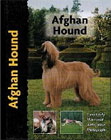
Click on the cover above
to go to this book
at Amazon.co.uk
|

Afghan Hound (Pet Love)
Bryony Harcourt-Brown
Interpet Publishing
ISBN: 1902389085
Afghan hounds are sighthounds with a reputation for being good-looking
but not very bright. This is not exactly true - though they are graceful
and elegant dogs, which are not keen on obeying commands, such as 'here'!
They are very bright when it comes to doing what they want to do, and
not doing things they don't want to do. Owners just need to work out
how to motivate them. They are independent, sometimes wary of strangers,
and need careful socialisation. They do need exercise in a safe area,
and like most sighthounds, are prone to chasing and catching small furry
animals. Their long coats need quite a lot of grooming or they can get
tangles and mat. Afghans are not the ideal dogs for people with children,
because they are a large breed which is not especially sociable, needs
a lot of attention, and is sensitive. These are very sensitive dogs,
both to stress and rough treatment, and they can react badly to some
chemicals and foods. Afghans also have a more than average susceptibility
to cancer, though they are relatively healthy for large breed dogs.
This is a good introductory book for new owners of Afghan hounds. The
history and character of the breed are well explained, and the book
is clearly written and well set out. It's a good introduction for novices,
though experienced owners are likely to want more.
 Top
of page Top
of page
|

Click on the cover above
to go to this book
at Amazon.co.uk
|

Afghan Hounds (The World of Dogs)
Lynda Race
Kingdom Books
ISBN: 1852791012
This guide to Afghan hounds covers more ground than Bryony Harcourt-Brown's
book, and is also more expensive. It's worth the extra for the advice
on showing, and fun activities with Afghans, as well as extensive advice
on how to care for the breed at all stages of their lives. There's plenty
to interest experienced owners, who will also love the pictures.
 Top
of page Top
of page
|

Click on the cover above
to go to this book
at Amazon.co.uk
|

The Basset Hound Owner's Survival Guide
Morgan
Hungry Minds Inc
ISBN: 0876050186
Anybody who takes on a basset hound needs a sense of humour. You will
really only appreciate the breed if you can laugh with your dog. Basset
hounds are very similar to bloodhounds, and both breeds are skilled
at drooling. Basset hounds are natural clowns, with sweet, gentle natures,
usually getting on well with other dogs and with children, but they
are not the most obedient of dogs. A basset likes to follow its nose,
rather than go where you want to walk, and they can get lost following
a scent. They can also be very noisy, and may howl if left alone.
Common health problems include hip dysplasia, luxating patella, hypothyroidism,
eye trouble, ear infections, bloat. They should also not be allowed
to get too fat, or do a lot of jumping, because this puts too much of
a strain on their backs. Like Dachshunds, another long-backed, short-legged
breed, Hassett Hounds can be difficult to houstrain.
This book captures the pleasures and frustrations of owning a Basset,
and is an enjoyable read, as well as being packed with useful tips.
 Top
of page Top
of page
|

Click on the cover above
to go to this book
at Amazon.co.uk
|

Beagles for Dummies
Susan McCullough
John Wiley & Sons (24 Nov 2006)
ISBN-10: 0470039612
ISBN-13: 978-0470039618
Beagles are popular as pets as well as working dogs. They are designed
to live in packs, so tend to get on well with other dogs. They are also
gentle with people, and are usually healthy. They are not easy to obedience
train, and get bored easily, finding ways of doing what they want rather
than what you want them to. Short daily training sessions from when
your Beagle is a pup are helpful for ensuring that beagles are reasonably
obedient, and they need to have rules clearly and consistently set out.
Children and well trained beagles usually get on well, though children
need to be aware that beagles can like rough play, so should not be
wound up. Beagles tend to be a bit mouthy, liking to chew a lot, and
mouth people, and they need to be taught that mouthing people is not
acceptable. Beagles are, however, quite tolerant of children and usually
enjoy their company. One serious disadvantage that owners often report
is poor recall - Beagles are prone to picking up a scent, following
it, then forgetting where they left their owners! They can also be noisy,
and some will bark, bay, and howl, especially when left alone. Common
health problems include epilepsy, hypothyroidism and eye trouble, though
generally they are a healthy breed.
Susan McCullough's book provides a wealth of information on the breed, including choosing a beagle, puppy care, behaviour and training, health care, and caring for senior beagles..
 Top
of page Top
of page
|
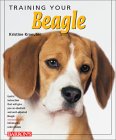
Click on the cover above
to go to this book
at Amazon.co.uk
|

Training Your Beagle
Kristine Kraeuter
Barron's Educational Series;
ISBN: 0764116487
This is a very clearly-written guide for Beagle owners, explaining
how to train their dogs. It covers a lot of ground, from the very basics,
to training for shows, but experienced beagle owners are unlikely to
find anything startlingly new. It is well-illustrated, and is certainly
a very useful book for a new owner of a Beagle.
 Top
of page Top
of page
|

Click on the cover above
to go to this book
at Amazon.co.uk
|

Bloodhounds: Everything About Purchase, Care, Nutrition,
Breeding, Behavior, and Training (A Complete Pet Owner's Manual)
Kim Campbell Thornton, Michelle Earle-Bridges
Barron's Educational Series
ISBN: 0764103423
Bloodhounds are gentle dogs which have long been used for their tracking
skills, and they are perhaps the best known scenthound dogs. They are
champion scenthounds, and do not want to give up a trail until they
have got to the end. This means that walking off leash is not an option
unless you have enclosed land. They are great droolers, and like to
give slobbery kisses. They also have a distinctive bay, which can upset
the neighbours, and they need a lot of patient training. They are generally
good with children and other dogs, though they do need careful training,
since they are a large breed, which can knock over small people, and
they are a little too strong and determined for smaller people to handle
easily on a lead. They may also slobber and drool on children (or give
them wet kisses). One disadvantage of the breed is that they tend not
to live long, like many large dogs.
Common health problems include allergies, entropion (eyelid inversion),
bloat, hypothyroidism, heart disease and hip dysplasia. This is not
a very long-lived breed, and it's worth checking the longevity of the
ancestors of any Bloodhound pups you are interested in.
This is a short book, but a delight for Bloodhound owners because of
the beautiful illustrations and the very clear picture it gives of the
breed. It's a good introduction to the breed, though owners are likely
to need more in-depth information if they succumb to the temptation
of taking on a Bloodhound.
 Top
of page Top
of page
|

Click on the cover above
to go to this book
at Amazon.co.uk
|

On the Trail: A Practical Guide to the Working Bloodhound
and Other Search and Rescue Dogs
Jan Tweedie
Alpine Publications Inc
ISBN: 1577790057
Bloodhound owners who want to understand what their dog is designed
to do can benefit from reading this guide to working search and rescue
dogs. These dogs are happiest when allowed to work, or take part in
recreational activities which involve tracking. This book explains how
to teach them the right skills, and how those skills can be put to use.
 Top
of page Top
of page
|

Click on the cover above
to go to this book
at Amazon.co.uk
|

The Borzoi (The World of Dogs)
Desiree Scott
Kingdom Books;
ISBN: 1852790938
Borzoi are also known as Russian wolfhounds, and may have been originally
developed to hunt wolves. They can run extremely fast, and will tend
to go deaf if you have them off the lead and they spot animals that
they can chase. A safe area for them to exercise is essential. They
are long-haired dogs which shed, and they are large dogs, which can
occupy a lot of your sofa, or bed! They are similar to greyhounds in
temperament, and can get on well with children and other dogs, though
being large and fast movers, it is easy for them to knock smaller children
over.
Borzoi aren't especially long-lived, and can suffer from a number
of medical problems. These include the common sighthound sensitivity
to veterinary phamaceutical products such as anaesthetics, bloat, heart
disease, and hip dysplasia.
This book explains the origins of the breed, which helps to understand
its special characteristics, and there is also information on the breed
in the UK. There is help with choosing and training a Borzoi, as well
as showing and breeding. The chapter on puppies is especially useful,
since diet and exercise levels are important for their proper development.
There is also very useful information on genetics for people wanting
to breed Borzois, or research their dog's pedigree.
 Top
of page Top
of page
|

Click on the cover above
to go to this book
at Amazon.co.uk
|

English Foxhound, a Complete Guide: a Complete Handbook
Emily Latimer, Suzy Reingold
TFH Publications
ISBN: 0793807743
Foxhounds are not generally kept as pets in the UK, but many dog owners
may consider them if hunts start getting rid of dogs in large numbers.
Foxhounds raised in the home as pups can be very engaging companion
dogs. Like most hounds, they do not excel in the obedience department,
but they are usually gentle, so long as they are taught bite inhibition,
and they usually get on well with other dogs. Training should be ongoing,
and short daily sessions are helpful, as is making house rules clear
from the start. Well-trained Foxhounds can be good with children, though
rough play should be discouraged so that it does not get out of hand.
They can co-exist well with other dogs in the same household, since
they are pack dogs. Fights can still happen, especially if too many
are kept together in a relatively small space, and they don't have enough
exercise. Rescuing several Foxhunds is not a good idea unless you have
a lot of space, can give them enough exercise, and know a lot about
hounds. Foxhounds can be noisy, which is fine if you want a watchdog,
but not so good if you have thin walls. They are also similar to beagles
in having poor recall once they pick up a smell, and they are not always
safe with cats. They are generally healthy, though as working Foxhounds
tend to be culled when they can no longer hunt. less is known about
diseases of middle and old age of Foxhounds than is known about breeds
more commonly kept as pets.
This book is a short introduction to the breed, and is well illustrated.
It is helpful if you take on a foxhound as a pup, but is not much help
for anyone who plans to take on a rescue ex-hunt foxhound. Such hounds
are really only for experienced owners with a lot of patience, and a
novice armed only with this book is likely to run into difficulties.
 Top
of page Top
of page
|

Click on the cover above
to go to this book
at Amazon.co.uk
|

Adopting the Racing Greyhound
Cynthia Branigan
John Wiley & Sons; 3rd Edition edition (29 July 2003)
ISBN-10: 0764540866
ISBN-13: 978-0764540868
Former racing Greyhounds are often taken on as pets, and they can
adapt well, though they often need house training, and, like many sighthounds,
some have a tendency to chase cats. They can move at an extremely fast
pace, even those rejected as too slow for racing, but, surprisingly,
they do not need much exercise, preferring a few quick sprints, followed
by long naps on a soft bed, preferably yours, if they can get on it.
They are much easier to live with if owners invest time in obedience
training as soon as their adoptee comes to live with them. Greyhound
rescue centres provide useful advice, and do their best to match dogs
to owners. Some ex-racing Greyhounds are so easy-going that they can
be take on by first-time dog owners, and can happily co-exist with children,
while others can be more challenging. Generally they co-exist happily
with other dogs in the same household, though they can easily be hurt
in scraps, since their fur does not provide much protection.
This book is an excellent guide to what to expect if you take on a
racing Greyhound, and it can help you to understand many quirks which
can surprise even experienced dog owners.
 Top
of page Top
of page
|
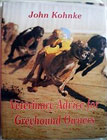
Click on the cover above
to go to this book
at Amazon.co.uk
|

Veterinary Advice for Greyhound Owners
John Kohnke
Ringpress Books
ISBN: 0948955872
This is an extremely useful veterinary reference manual for people
involved with Greyhounds and Whippets. It covers a lot of ground, and
it is very easy to find the information you need. The book is also inexpensive
for the amount of information it contains.
 Top
of page Top
of page
|

Click on the cover above
to go to this book
at Amazon.co.uk
|

The Lurcher
Frank Sheardown
Swan Hill P;
ISBN 1853108308
Lurchers are not a breed as such, but a cross between greyhounds and
other breeds such as collie, terriers, or wolfhounds, so though Lurchers
tend to behave like typical sighthounds, they can vary a great deal
in their biddability. They do, however, tend to be gentle dogs, so can
make good family pets for people with large, enclosed gardens. They
generally get on well with other dogs, though since they are crosses,
this can vary. Some Lurchers like to do sighthound rushes at other dogs,
veering away at the last minute, and this is not always appreciated,
though some dogs see this as an invitation to play.
This is a very good guide to Lurchers, which looks at different variations,
and is geared to those interested in working Lurchers. There is a lot
on the history of the breed, as well as the different sorts of work
carried out by Lurchers. Not a book for people worried about dogs catching
bunnies!
 Top
of page Top
of page
|

Click on the cover above
to go to this book
at Amazon.co.uk
|

New Complete Lurcher
David Brian Plummer
Swan Hill P
ISBN: 1853109924
Plummer has a very engaging writing style, and he excels in anecdotes,
which also make important points about the breed. This gives a good
overview of Lurchers, and their use as hunting dogs, with a lot of useful
tips for owners of Lurchers, on general care, training, showing, and
breeding them.
 Top
of page Top
of page
|
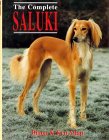
Click on the cover above
to go to this book
at Amazon.co.ukv
|

The Complete Saluki (Book of the Breed)
Diana Allan, Ken Allan
Ringpress Books
ISBN: 186054195X
Salukis are exceptionally beautiful dogs, and a very ancient breed,
originating in the Middle East. Like most sighthounds, they are at risk
from being hit by cars when they run off especially when they are young,
but older Salukis can make good jogging companions if you can find a
large area which is a long way from roads to jog in. They are very clean,
can be finicky about their food, and are usually gentle dogs, getting
on well with other dogs, and children who respect them. Health problems
include the usual sighthound sensitivity to chemicals, though the biggest
risk to their health is traffic.
This is a good overview of the breed, with tips on general care, coursing
and showing, and wonderful illustrations. It's worth getting the book
for the pictures alone.
 Top
of page Top
of page
|
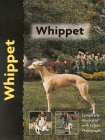
Click on the cover above
to go to this book
at Amazon.co.uk
|

Whippet (Pet Love)
Juliette Cunliffe
Interpet Publishing
ISBN: 1902389069
Whippets are a contradictory breed. They look delicate, and can easily
suffer injuries because of their thin fur, but they are tough little
dogs out in the field, good hunters, and bold. They like running fast,
and also curling up next to their owners, preferably lying on something
soft. They are good sources of heat in winter. They are generally gentle
with people, and can live happily with other dogs, but their peacefulness
should not be taken for granted. It may be tempting to keep several
of these dogs, because they are small and appear gentle, but fights
can still happen in packs, and the more dogs there are, the more dangerous
a pack fight can be. Sensible precautions such as not keeping too many
dogs, or same-sex littermates are a good idea, even if your Whippets
live together as a peaceful pack, sleeping in a warm heap. Whippets
are generally healthy, and a long-lived breed. Their numerous good qualities
make them favourites of many people, not just in Northern England!
This book is packed with information about Whippets, including the
breed's history, training and general care, and the author is clearly
a fan of this engaging breed.
 Top
of page Top
of page
|

Click on the cover above
to go to this book
at Amazon.co.uk
|

The Whippet (World of Dogs)
J. P. Moran-Healy, J.P. Moran-Healy
Kingdom Books
ISBN: 1852790962
This book covers more ground than Juliet Cunliffe's book on Whippets,
and is more expensive. It is very well illustrated, and gives a thorough
account of the breed's history. Experienced Whippet owners will find
much that interests and delights them in this book.
 Top
of page Top
of page
|

Click on the cover above
to go to this book
at Amazon.co.uk
|

Working Longdog
Frank Sheardown
Swan Hill P
ISBN: 1840370602
Longdogs are sighthounds such as Afghans, greyhounds, salukis, wolfhounds,
or crosses between sighthound breeds. Frank Sheardown believes that
sighthounds should work for a living, and he provides help with choosing,
caring for and training sighthounds with this objective in mind.
 Top
of page Top
of page
|
See also:
 Dogs:
Breed profiles and breed books Dogs:
Breed profiles and breed books
 Dogs:
Health and Nutrition Dogs:
Health and Nutrition
 Dogs:
General Dogs:
General
 Dogs:
Origins, canine evolution and wolves Dogs:
Origins, canine evolution and wolves
 Training, puppy and adult dog good manners Training, puppy and adult dog good manners
 Advanced training, including gundog training Advanced training, including gundog training
 Fiction and biography relating
to dogs Fiction and biography relating
to dogs
 Ferrets: General advice Ferrets: General advice
 Ferrets: Books on ferrets Ferrets: Books on ferrets
 Click
here for hounds on stamps Click
here for hounds on stamps
|